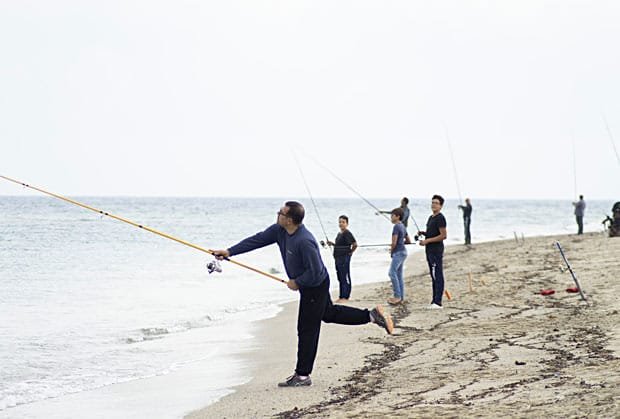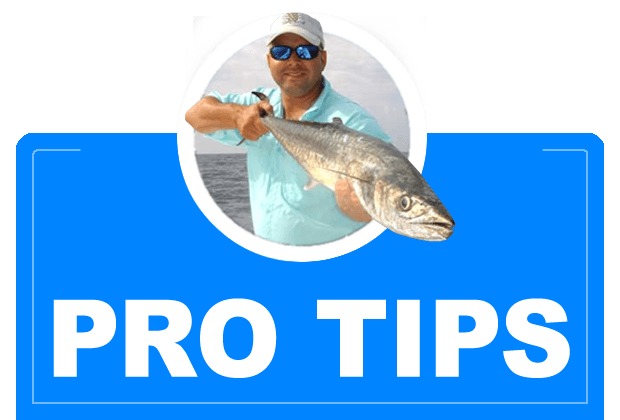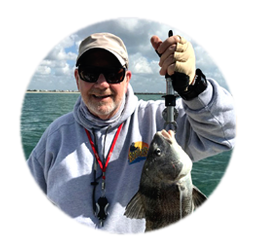Better Casting Can Mean More Caught Fish
In my years as a professional charter captain and guide, you might be surprised at how many of my customers do not know the proper techniques to good casting. Knowing how and when to employ a certain type of casting is very important to your fishing success. Let me try to walk you through this process.

When it comes down to it there are basically two types of casts: overhand and side arm. Overhand is used when you want to obtain the most distance or when there are no obstructions to your desired landing spot. Side arm casting is usually used when trying to throw your bait under an obstruction, such as trying to place your bait under a dock. The first imperative for either type of cast is to put two hands on the fishing rod. One hand is near or just in front of the reel (spinning) or just behind the reel (casting) and the other hand is on the butt of the rod. One tidbit I use was learned from golfing. Just as in golf you should point your lead shoulder where you want the ball to go, you should use the same technique for where you want your bait or lure to go. Believe me this alone will improve your accuracy. The next point has to do with timing; that is the time when you release the line. With spinning tackle if you release too soon, the bait goes almost straight up with little chance at the desired results. You let the line go too late it splashes in the water loudly about fifteen feet away. Again, not the desired results. For long casts, practice letting the line go around ten o’clock or maybe ten fifteen. For side arm casting practice letting go at three o’clock or so to achieve a line drive. Again, two hands on the rod!
Be sure your bait rig or lure leader is not too long or for that matter not too short. Today’s highly sensitive graphite rods need to be able to “load” in order to perform as you would desire. When you bring the rod and rig overhead or side arm you should bring it backwards until you feel it load (bend), then you can whip it forward fast or slow depending on your desired location and distance. When fly casting feeling the rod load is imperative to successful casting; that type of casting is for another chapter.
Another consideration is the length of your fishing rod. For inshore fishing, a six foot or six and a half foot rod is better for accuracy while a seven foot or even seven and a half foot rod is better for distance. While I do a fair amount of near shore and offshore fishing, I mostly fish inshore. My standard choice of rods is seven foot for trout and six and a half foot for everything else.
One last thing, PRACTICE! Even when you are really fishing think about what you are doing and visualize where your target is and measure your success on how close you come to achieving that target! With practice you will catch more fish.
Good Fishing!
About the Author: Captain Rick Bennett started building custom fishing rods in 1984 and became a licensed charter boat captain in 1996. Adding custom rod building to running charters he became Rod-Man Fishing. Captain Rick Bennett has also been doing fishing seminars for almost 25 years. Known as the Rod-Man, today he’s a guide for folks on their boat showing fishermen the where, how and what for catching fish. Captain Rick Bennett continue’s to build custom fishing rods. You can visit his website here or call Captain Rick Bennett at (910) 520-7661
A lifetime fisherman, Capt. Rick Bennett, better known as the Rod-Man,has retired from the day to day activities as a charter boat captain but does offer “ON YOUR BOAT” Guided Fishing Trips. Capt. Rick will show you the when, the where and the how. From rod and reel selection to terminal tackle to bait, Capt. Rick has the know how.
- Choosing the right fishing line
- Saltwater Fishing late May and into June
- Flounder from an Artificial Perspective
- Local Carolina Beach fishing in the month of April
- How to Build Your Own Custom Fishing Rods (Part 5)
- How to Build Your Own Custom Fishing Rods (Part 4)
- How to Build Your Own Custom Fishing Rods (Part 3)
- How to Build Your Own Custom Fishing Rods (Part 2)
- How to Build Your Own Custom Fishing Rods (Part 1)
- Surf Fishing Carolina Beach, North Carolina (Part 2)
- Surf Fishing Southeastern North Carolina (Part 1)
- Exciting shark fishing for everyone.
- Fishing for Mahi-Mahi
- “Specialty” Gear for Inshore Fishing
- Fishing for Spanish Mackerel
- Cobia fishing trips and tips, hard fighting, good eating
- Fishing tips on how and where to catch Black Drum
- How to catch Speckled Trout fishing tips and tricks
- How to catch Flounder, flounder fishing tips and tricks
- How to catch redfish, red drum fishing tips and tricks
- Reds and trout and some flounder are biting on artificials
- Atlantic bonito have been caught at the near shore AR’s. Bluefish have been plentiful.
- The wahoo bite is good and some blackfin tuna and sailfish are in the mix.
- Kings are still way out, but the Gulfstream is producing wahoo and blackfin tune.



 About the Author: Captain Rick Bennett started building custom fishing rods in 1984 and became a licensed charter boat captain in 1996. Adding custom rod building to running charters he became Rod-Man Fishing. Captain Rick Bennett has also been doing fishing seminars for almost 25 years. Known as the Rod-Man, today he’s a guide for folks on their boat showing fishermen the where, how and what for catching fish. Captain Rick Bennett continue’s to build custom fishing rods. You can
About the Author: Captain Rick Bennett started building custom fishing rods in 1984 and became a licensed charter boat captain in 1996. Adding custom rod building to running charters he became Rod-Man Fishing. Captain Rick Bennett has also been doing fishing seminars for almost 25 years. Known as the Rod-Man, today he’s a guide for folks on their boat showing fishermen the where, how and what for catching fish. Captain Rick Bennett continue’s to build custom fishing rods. You can